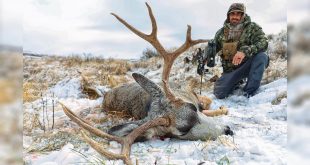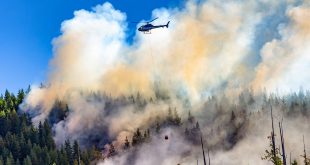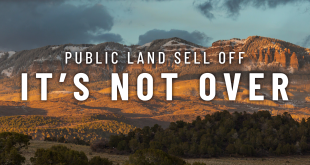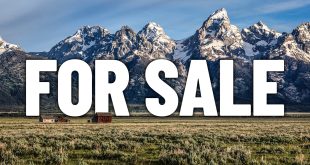Ike Eastman and Dan Pickar break down the public land sale in the Senate Budget Reconciliation Bill (Big Beautiful Bill). They discuss what could be lost, how it impacts Wyoming, its wildlife, and the nation, and what you can do to help to stop it.
David Willms – Associate Vice President for Public Lands
Before joining the National Wildlife Federation, David served as a natural resources policy advisor to Wyoming Governor Matthew H. Mead, and a natural resource attorney in both the public and private sector. He also teaches a graduate course on the Endangered Species Act at the University of Wyoming, and writes frequently on various wildlife and land management issues.
David received a B.S. in Wildlife and Fisheries Biology and Management and his Juris Doctorate from the University of Wyoming. He lives in Cheyenne, Wyoming, with his wife and three young children.
On June 11th, Senator Mike Lee (R-UT) released a proposal as part of the Senate Energy and Natural Resources Committee’ contribution to the Senate’s budget reconciliation bill—otherwise known as the “One Big Beautiful Bill Act.” Unless you’ve been a contestant on “Alone”, or otherwise lost in the backcountry, you know that this provision mandates the sale of millions of acres of public lands across the West. But, you may not know everything it does.
So, here’s a no-frills breakdown of what’s in the bill, what it does, and WHAT TO DO if you’re concerned about losing access to your favorite hunting spot.
Mandates a Massive Sell-Off of Public Land
The bill requires the Secretary of the Interior and the Secretary of Agriculture to begin disposing of, “as soon as practicable” after bill passage, and every 60 days after that:
- Not less than 0.5% and not more than 0.75% of all Bureau of Land Management (BLM) managed surface acres nationwide; and
- Not less than .05% and not more than 0.75% of all National Forest System (USFS) lands created from the public domain.
Framing this in terms of percentage of overall acreage instead of actual acres is a clever way to make it look like these sales do not impact much. However, this translates into a mandate that the BLM and USFS sell at least 2 million acres and up to just over 3 million acres of public lands—within five years. On the high end, that’s an area larger than Yellowstone and Yosemite National Parks combined. Stated another way, we could sell every acre of Rhode Island and Delaware, and still need to sell over a million acres to meet the mandate of this proposal. That’s a lot of land.
Where Would Sales Occur, and What’s Exempted from Sale
Lands are eligible for sale in 11 western states—all of them from the Rockies to the Pacific—except Montana. Within those states, millions of acres are excluded from sale. For example, there are 15 different exemptions for lands designated by Congress or the Antiquities Act for things like National Parks, Wilderness Areas, and National Monuments. Additionally, the bill excludes “valid existing rights”, which it defines to include things like mining claims, grazing permits, mineral leases, and rights of way—among other things.
So, with all of these exclusions, what is actually eligible for sale? In short, everything else. This can certainly include degraded parcels in or near municipalities, but it can also include things like Wilderness Study Areas, Inventoried Roadless Areas, and countless parcels of remote, wild, and lightly managed lands that offer prime elk, mule deer, pronghorn, and upland bird habitat.
There is also a very real risk of lands that are currently exempted becoming eligible for sale. On May 27th, the Department of Justice issued a memorandum analyzing the President’s authority to revoke national monument designations made by predecessors using the Antiquities Act. The memorandum concluded that the President has such authority should he choose to exercise it. Many monuments designated in the past three decades remain BLM and USFS lands, and are administered by those agencies. This means that should the President rescind national monuments like Bears Ears, Grand Staircase, or Chuckwalla, those acres could then be eligible for sale under this bill.
All of this means that determining which lands are truly eligible for sale is a difficult proposition. Several maps are circulating online depicting lands that could be eligible for sale. These maps almost certainly contain errors, but they are a good starting point since the author of the public land sale provision did not provide any maps of his own depicting lands eligible for disposal.
What Lands Will Be Sold? It’s Vague—And That’s the Problem
Under the bill, the Secretaries of Interior (BLM) and Agriculture (USFS) can nominate lands for sale. However, the bill also allows “interested parties” to nominate land.
The term “interested parties” is undefined. It expressly includes states and local governments. However, without further definition it may also include developers, corporations, individuals, wealthy landowners, or even foreign entities or governments.
Once the Secretary or Interested Parties nominate land, the Secretary must prioritize lands for sale that are (1) nominated by States or local governments; (2) adjacent to existing developed areas; (3) have access to existing infrastructure; (4) are suitable for residential housing; (5) reduce checkerboard land patterns; or 6) are isolated tracts that are inefficient to manage.
The listed priorities are not an exclusive list. Each Secretary has broad discretion to prioritize other types of land they wish to sell under a very squishy purpose (detailed below). Importantly, there’s also no requirement that nominations consider impacts to public access, wildlife values, water, or important traditional uses like hunting and fishing.
Purpose of Land Sales: Housing Is the Justification—But Not the Requirement
Proponents of selling public lands have marketed this bill as a solution to the West’s housing crisis, claiming that these land sales will free up space for “affordable housing.” But do not take the bait. As currently drafted, this bill will not address the affordable housing crisis. In fact, it does not use the word “affordable” a single time. The closest it comes is saying that the one nominating land for disposal must explain the extent developing the parcel would “address local housing needs (including housing supply and affordability).” But, the very next section, which mandates what the Secretary considers when selling a property, does not require prioritizing affordability. In fact, it does not even require that the land be used for housing of any kind.
Instead, it says lands must be used for “housing or to address associated community needs”—a phrase that is undefined and left up to the Secretary to interpret. “Associated community needs” could include luxury homes, data centers, golf courses, business parks, or any number of other uses that have little or nothing to do with affordability, or even housing.
Mandated Land Sales Give Preference to States, Local Governments and Large Landowners
Admittedly, the lands most likely to be sold under this bill are those in the hills, foothills, and open spaces near western communities. These are often the most valuable and scenic real estate around. Anyone who has tried to buy property near Jackson, Flagstaff, Bend, Vail, or St. George knows these lands don’t come cheap. Selling them at fair market value (as the bill requires) makes affordable housing even less likely.
The bill also gives states or local governments a right of first refusal on land purchases. What does this mean? Well, it means if a Tribe, corporation, individual, or other interested person has earned the right to purchase the land, a state or local government can purchase it instead. And that’s not all. The bill contains a provision that limits someone from purchasing more than two parcels of public land at a sale. However, states, local governments, and landowners adjacent to nominated parcels are not limited in what they can purchase.
This means two things. First, this bill is really constructed to facilitate transferring as much land to states and local governments as possible. Second, it creates a path for certain landowners to lock up lands. Here’s an example of how this could work in practice. Let’s use the ranch at the center of the corner crossing controversy in south central Wyoming, which is checkerboarded BLM land on exceptional elk habitat. Under this bill, the owner of that ranch could voluntarily cancel his grazing leases on BLM lands adjoining his lands (remember, lands with grazing leases are exempt from sale). Then, he could immediately nominate those parcels for disposal, and purchase them all. It could meet the “associated community needs” test because it would create new property tax revenue for the county—an obvious need. Also, reducing checkerboard land patterns is a mandated priority for the Secretary to consider in a land sale. No more checkerboard. No more corner-crossing. No more hunting.
In short, this bill isn’t about helping working families find homes—it’s about paving the way for land disposal with no public input.
What about Public Input or Public Process? There is None
Many people do not know this, but there is an existing process to dispose of public lands. Congress passed the Federal Land Planning Management Act (FLPMA) in 1976 to ensure that public lands are managed for multiple uses—grazing, recreation, energy, wildlife and fisheries, clean water, and more. It also established that lands managed by the BLM remain in public ownership unless there’s a strong case for disposal. Here’s how that typically works:
- BLM conducts land use planning, including public meetings and coordination with state and local governments.
- Lands identified for disposal go through a transparent review process, often including environmental analysis under the National Environmental Policy Act (NEPA). Just because land is identified as suitable for disposal, does not require that the land must be sold, nor does it provide any timeline for sale.
- The public gets a chance to weigh in, including local residents, hunters, ranchers, Tribes, and others who use or value these lands.
- Sales occur at fair market value, and include public notice and a competitive bidding process, unless certain exemptions apply.
- Congressional notification required for sales exceeding 2,500 acres. Congress has 90-days for either body to formally disapprove, or the sale can proceed.
Of course, this means that the process can be slow because of all of the various boxes that must be checked before a parcel is sold. However, that process exists for good reasons. It ensures that land isn’t sold off just to meet a short-term political or budgetary goal and that local voices are heard before public land changes hands. Remember, public lands can only be sold once. Once sold for development, they are gone from the federal estate forever.
This bill completely bypasses FLPMA, including the public process for land use planning, the public process for identifying parcels that could be subject to disposal; the requirements for conducting a sale, and the duty to notify Congress. Instead, this bill deems any parcel sold under its provisions as complying with FLPMA. It completely takes the public out of the process, only requiring consultation with the Governor, local government and “each applicable Indian Tribe” prior to selling public lands.
Where Does the Money Go? Not Where It Should
Under current law—specifically the Federal Land Transaction and Facilitation Act (FLTFA)—when BLM lands are sold, the proceeds go into a fund that helps acquire high-priority conservation lands and access easements so we don’t wind up with fragmented landscapes or blocked access. In short, the proceeds ensure that by selling fewer desirable lands, we are able to invest in replacing those acres or improving acres in a way that achieves a net positive for our public lands. But this bill changes those rules. Under this proposal:
- 90% of the revenue would be sent to the U.S. Treasury
- 5% would go to local governments
- 5% would go to deferred maintenance on public lands in the state where the sale occurred
The bill’s proponents anticipate raising $5 to $10 billion through these sales, yet hardly any of that money would be reinvested in the land or the users who rely on it. This is a raw deal for the people who care for, work on, and recreate on public lands.
Why Hunters and Anglers Should Be Alarmed
Make no mistake: This proposal is the most aggressive public land disposal effort we’ve seen in decades. It’s a mandated, fast-tracked land sale that removes public involvement and undermines the long-standing principle that public lands should stay in public hands unless there’s a compelling reason otherwise.
For hunters and anglers, the consequences are enormous:
- Loss of access to millions of acres that are open to hunting, fishing, and camping today
- Loss of habitat critical to big game, birds, and fish—especially in winter ranges, migration corridors, and riparian zones
- Loss of economic activity in rural communities that rely on outdoor recreation
- Creates a precedent, making it easier for similar efforts to be pushed in future Congresses
In states like Wyoming, Idaho, Montana, Nevada, and Utah—where public lands make up the majority of the landscape—this bill would fundamentally alter where and how we hunt, fish, and raise our kids to do the same.
What’s Next and What You Can Do to Help
This bill hasn’t passed yet. This means that changes to text could be forthcoming. A draft of new text started circulating on June 14th that would have stripped the exemption for grazing leases (meaning millions more acres could be jeopardized), and tried to tighten language around using lands for local housing and associated infrastructure (unsuccessfully). Agriculture interests quickly rang alarm bells and received assurances that no grazing leases would be sold.
This quick reaction from Senators shows this can be stopped—but only if people speak up.
Here’s how you can help:
- Call your Senators and tell them to oppose any effort to sell off our public lands. Come with facts, not hyperbole. Remind them that the overwhelming majority of voters in their state, regardless of political party, oppose selling public lands—yes, even in Utah.
- Call county commissioners, state legislators and other elected officials that may have the ear of your elected senators. They need to hear from their constituents and advocate on their behalf.
- Spread the word to your hunting and angling circles, and beyond. Many people haven’t heard about this proposal yet.
- Social media is a powerful tool to spread the word. Use it.
- Support conservation organizations that are actively working to defend public land and access. They are working around the clock on your behalf to fight back on this sell-off.
- Call your Representatives because if the Senate passes a bill with land sales in it, the House gets another shot at removing it. Our most ardent defenders like Representatives Zinke (R-MT), Downing (R-MT), and Simpson (R-ID) need our continued support, and help finding additional allies.
We’ve defended public lands before—and we can do it again. But it takes all of us showing up and speaking out.
The Bottom Line
This Congressional proposal is a direct threat to our shared legacy of public lands. If passed, it would constitute the largest public land sell-off in modern U.S. history, and would do little—if anything—to meaningfully address affordable housing.
For those of us who hunt, fish, and rely on open spaces, this fight isn’t about politics. It’s about preserving what makes the West special—for our generation and the next. To paraphrase Representative Zinke: public lands aren’t red. They aren’t blue. They are red, white, and blue.
 Eastmans' Official Blog | Mule Deer, Antelope, Elk Hunting and Bowhunting Magazine | Eastmans' Hunting Journals
Eastmans' Official Blog | Mule Deer, Antelope, Elk Hunting and Bowhunting Magazine | Eastmans' Hunting Journals





How about we work on keeping public lands public or we are all out of business? Unless you are like the guy in New Mexico that spent over 1million $ on a sheep tag!
More wolves isn’t the answer
Dan, thanks again for the research and your thoughts about what we, as hunters who care about conservation, can do to preserve wildlife for the future. Watching your career unfold has been rewarding. As a lifetime Montana resident and hunter, I’ve lived the amazing population increases and now the decline due to reasons many of us would never have imagined. I believe this video needs to be spread among as many hunters as possible. Understanding why some populations may be declining AND specifically how anti hunting communities tie up management in court, is indeed enlightening. Knowing what to call these practices while speaking to our representatives will matter long term. I’ve yet to meet you face to face Dan. We’ve communicated several times about controversial issues regarding potential MTFWP donations from anti-hunting groups. Keep the great info coming!
– Ger Brunckhorst, Lakeside, MT.
What do you expect when you stupidly reintroduced wolves. They have eaten most of the big game up in the first 10 years. Now I bow hunt I get surrounded by howling wolves.. dumbest things environmentalists have d e after stopping good logging .
Are you guys aware of the Budget Reconciliation Bill that Mike Lee and Steve Daines have added on the bill that requires selling 40% of Public Land across the Western States?
If this is true, this is the biggest threat to hunting that we currently face!
I was shocked when I read about it. Interesting because Senator Daines is from Montana it has no land on the list for sale!!!
Well Ike, first of all, you should tell your subscribers the real truth. It’s the Congressional Republicans who your family and Todd Helms worship who are hell bent on stealing our public lands. You brag how you’re such patriots and are speaking to the choir like all gun owners and sportsman are part of this cult train you’ve jumped on.
We all want access to our public lands, but if this BS is jammed down our throats, we won’t have to be concerned about our rights to corner cross. All the checkerboard public lands will be sold to the rich ranchers and highest bidder who support this Facist regime.
I’ve been a subscriber to your magazine since it’s inception when your Dad kept the content family oriented and non-partisan.
And just so you know, I’ve been an independent all my life and vote for the candidate who serves in the best interests of everyone in this country regardless of party affiliation.
It’s not just Eastmans! It the entire hunting and outdoor industry! There have been millions of dollars spent by sportsmen over the years to support them! They need to use their influence to stop this now! Cabela’s, Winchester, Remington, Realtree, Orvis, Browning, Savage, Hornady! The list could go on forever! I’m pissed! They are so partisan that we could all lose what we value the most!
I live in Michigan. I used to go hunt elk, mule deer and antelope out west.
The residents b1tched and cried for years until it is all but impossible for me to get a tag and on the rare occasion I do, I have to pay 40-50 times what a resident pays.
So you know what? I no longer GAF what happens to public land out west because I can’t use it.
So whatever. Sell it all except the National Parks. Why should I care? You all forced us out, don’t expect us to fight for the resources now.